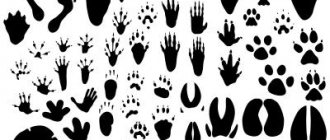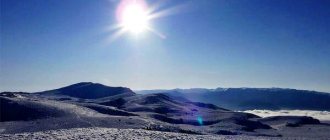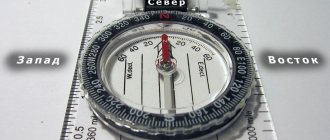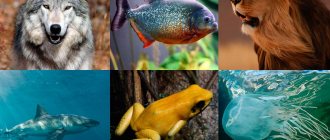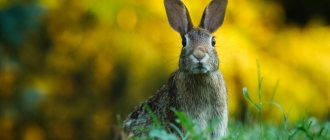Moose trail
It is difficult for an experienced hunter to confuse the tracks of an elk with the tracks of other animals. Of course, they are very similar to the hoof prints of cattle and some wild elk relatives, but they are significantly larger in size. The hooves of a male elk, even if of average build, are always larger than the hooves of the largest domestic bull. In general, the elk walks heavily and sinks deep into the loose snow, down to the ground. The stride length is usually about 80 cm. When trotting, the stride is wider - up to 150 cm, and when galloping, jumps can reach 3 meters. The width of the print, excluding the lateral toes, is about 10 cm for moose cows and 14 cm for bulls, and the length is 14 cm and 17 cm for females and males, respectively.
Photo of moose tracks in the snow added by user z.a.v.77. in 2017.
What is trace freshness and how is it determined?
It is interesting for the observer, and important for the hunter, to know when this or that trace was left. The animal passed here a few days ago, or maybe hours? Or is it still running somewhere ahead? This is indicated by such a concept as the freshness of the trace.
If it snowed late in the evening or at night, then a bear’s paw print found in the morning will indicate that it is nocturnal and no more than a few hours old. You should be careful, because in winter only the connecting rod bear can leave its prints.
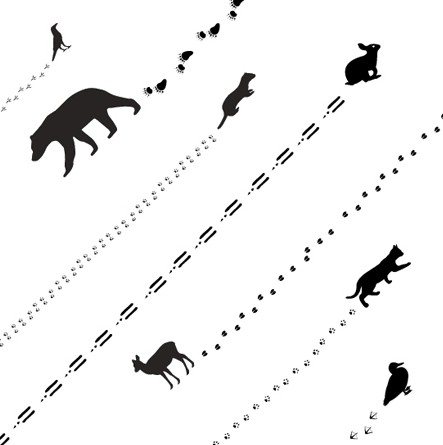
Experts suggest determining the freshness of a trace by touch. If it is frosty outside and the snow is dry, then at first its boundaries will not differ in looseness from the rest of the surface. Over time, the walls of the footprint harden. This process directly depends on the air temperature. The stronger the frost, the faster the edges of the print become hard. But this only applies to large animals, for example, if these are traces of a brown bear or a wolf. Because small animals leave imprints on the surface. And there the hardening is not noticeable.
hare trail
Hares leave two long hind paw prints in front and two shorter front paw prints behind them. In the snow, the length of the footprint of the front paws is about 8 cm with a width of 5 cm, and the length of the hind paws is up to 17 cm, with a width of about 8 cm. Due to their specificity, the tracks of the oblique are not difficult to determine, as is the direction of its movement. Hiding from pursuit, a hare can make jumps of up to 2 meters, and in a “calm environment” the length of the jump is about 1.2 - 1.7 meters.
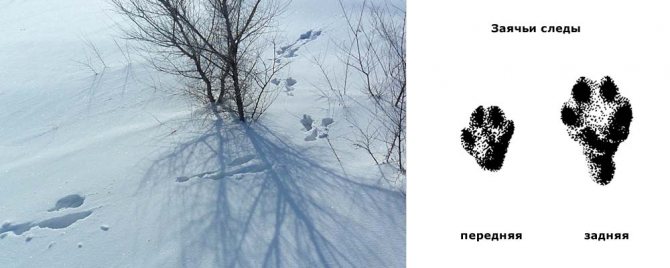
A photo of hare tracks in the snow was added by Laichatnik in 2015.
Freshness of the moose track
The heavy snow that has fallen in the forest reminds us that drives for elk, hare and roe deer will soon begin - the most common collective hunts in Siberia. Not the last activity in such winter hunts is the ability to determine the freshness of an elk or roe deer track in the snow. Most often this is the job of a huntsman, but there are such “craftsmen” who can drive hunters through already empty paddocks, mistaking old tracks for fresh ones. At the same time, they do not forget to issue an invoice for servicing the hunters. In order to avoid becoming a victim of incompetent and unscrupulous hunt organizers, you should, if possible, know how the freshness of an elk track is determined, because this activity itself is not only exciting, but also useful.
Roe deer and moose are usually nocturnal. The exception to the rule is frosty days, when the elk begins to fatten before sunset and only lies down towards noon. In the morning after an overnight snowfall, you can easily read in detail the entire night movement of the animal. When there is no snowfall, the number of tracks in the snow gradually increases, therefore, the hunter should follow only the last, freshest track, which leads to the animal’s bed. To understand the freshness of an elk track, the hunter must have keen vision and a subtle sense of touch and the ability to make accurate and correct conclusions.
Moose tracks.
The footprint itself and how it will look is influenced not only by the snow itself, but also by its moisture, condition, depth and exposure to winter wind and numerous other weather conditions that affect the strength and appearance of the trace. The mark should mean all those changes that an elk can leave not only on the snow, but also on trees, grass, or in general on all objects that the animal can reach or touch. Therefore, the mark left by the animal will look like: scratches (on snow or trees), various marks that are left by the horns on objects, beds, bleeding, internal secretions, objects falling from the back or from the body of the elk (grains of sand, earth, water and pine needles) ). As well as objects touched by the animal, for example, frost from branches or snow from dead wood, etc.
When talking about the footprint and the recognition of freshness, it is worth mentioning the dragging or dragging as the main part of the tracks in fresh snow. When the elk takes his leg (hoof) out of the snow, leaving a hole and bringing it to the next step, he simply drags a lot of snow out of the hole, while plowing the snow surface. And since the rise of his leg occurs gradually (especially with a fast step or gait), then after it there remains a large line from the exit from that hole after the leg rises above the snow. This feature, or also called a tray, at the exit surface of the fossa, the trace is often even wider than the fossa itself, and then usually narrows, turning into a small dash.
The tray, which starts from the front wall of the track fossa and continues with a line until it ends or begins to merge with the line from the lowering of the leg, which descends one step, is called a drag. The drag most often consists of not just one feature, which manifests itself during the alert step of the animal and in shallow snow, but also a large part of the track hole, the edges of which are severely disturbed by the lifting of the leg, together with the dragged and stirred up snow.
For about the first half of the distance between steps, the foot gradually lowers before stepping into the snow to complete its step, leaving a long line in the snow called the drag. The drag initially runs as a thin line, which is a continuation of the drag and expands, thereby revealing a decent strip, the width of a hoof, when the foot steps into the snow. The wire and the wire are occasionally connected; sometimes there may be a small gap between them. The descent into the hole from a drag mark is usually more gradual than the ascent from another trail, a drag. It indicates a certain direction of movement of the elk with ragged breaks on the surface during loose snow and blizzards. A wild boar, moving through shallow snow, can leave a trail, like an elk, but in the deepest snow covers it leaves a trench, giving the hunter his own direction of movement, just like when dragging.
What affects the freshness of traces?
For elk, the freshness of a track is most often influenced by the condition of the snow in the forest. There are different types of snow: light, wet, loose, damp, slightly touched by a thaw or rain, falling before a change in weather conditions in the form of small grains, compacted by cold winds or melted by the hot sun, frozen then to a certain degree of crust. The various shades of freshness of the snow depend on the lighting itself, and the sun always helps the hunter-pathfinder, although sometimes it has the ability to imperceptibly rejuvenate sometimes old, already reliably preserved tracks.
The easiest time to understand elk tracks is after snowfall, when snow has fallen at night and covered most of the old tracks. Powder is also called long if the snow stopped long before morning (or, for example, in the evening), and short if the snow suddenly stops falling long before morning. Traces from such powder usually do not require determination of their freshness. Sometimes, with a long powder, doubts may arise about the trace and its freshness, but it will be even more difficult if there is no such powder at all.
Natural phenomena sometimes make it possible to accurately determine with high probability the freshness of an elk track. Such phenomena are: frost, thaw that follows frost, snowfall, frost or snow fall in the undergrowth or significant temperature, as well as large drifts.
During a thaw, the footprint is imprinted very clearly and in detail, as if on raw clay, only with a white tint. In cold weather, the imprint becomes like a footprint on dry and loose soil. A footprint located in a warm thaw and exposed to frost looks like solid ice. If the thaw continues and then intensifies, then the trace begins to blur and gradually loses its details; a fresh trace during the most severe thaw looks like an imprint in liquid mud.
Fox trail
Fox tracks allow an experienced hunter to determine the nature of its movement. A fox paw print is typically about 6.5 cm long and 5 cm wide. The step length is from 30 to 40 cm. However, during a hunt or when escaping pursuit, the fox makes fairly long (up to 3 m) jumps and throws forward, to the right or left - at right angles to the direction of movement.
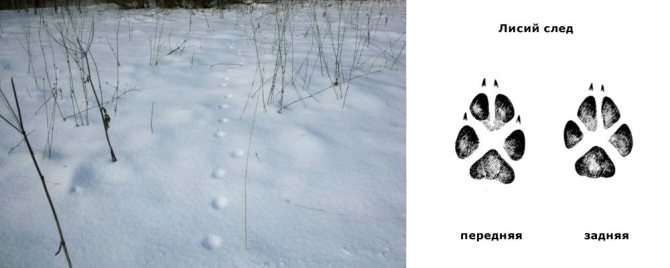
Photo of fox tracks in the snow added by user kubazoud in 2016.
Fox tracks in the snow: how to recognize behavior

By carefully examining the prints belonging to a fox, you can determine its behavior and the nature of its step. Normal jogging or trotting leaves an even line of tracks at the same distance from each other (30-40 centimeters), while the indentations are strict and symmetrical. If a fox is in search of prey, its path will consist of winding tracks, multiple passes, pokes, doubles, etc. If the animal goes over a long distance, or at the onset of the rut, the nature of the trail changes to a trot with a double, while its usual even chain doubles, turning into a series of parallel tracks, in which one of them can grab the edge of the other. To move along deep, loose snow, the fox begins to gallop, the length of the steps is about two meters, leaving four prints of all paws, with one line of two hind paws and scattered front tracks.
When pursuing prey, the animal can walk in a quarry, or at an extended gallop, with the prints of all four paws located scattered with more pronounced ones on the hind paws, which the fox throws forward like a hare. In this case, it is very easy to determine where the animal is heading.
The trail of a well-fed fox that has gone to bed is characterized by a small distance between steps and straightness, which makes it easy to track it. It often happens that the fox's path leads to the hare's path. In this case, you must try to track the animal along the trail until the exit to the fox tracks is found.

Fox tracks in the snow: photo
On dry and deep snow it can be difficult to understand the direction of a moving animal, since the ends of the paws are almost invisible. In such cases, you need to rely on the fact that all animals that move at a trot or walk have a print with dragging and dragging. They help to understand in which direction the fox is moving, since the drag remains after it draws a short line in the snow when it removes its paw from the track hole to take the next step. When an animal puts its paw on the snow, it leaves a drag - a long line on it. A short line from the track helps to understand the direction of the animal’s movement.
If a path in deep snow turns out to be such that the drag and drag are mixed into a continuous line, this makes it difficult to determine the direction of the animal. In this case, you need to take a closer look at other signs that help you understand the direction, for example, twigs or blades of grass along the fox’s path may leave lines on the surface of the snow. By the direction in which they bent under the weight of the animal’s body, one can determine the direction of movement. This technique allows you to determine the direction not only of a fox, but also of any other animal.
It is much easier to determine the direction of the fox by the downed snow that forms when it jumps over hummocks or other obstacles. The prints lead in the direction in which the snowballs fell.
Bear tracks
The tracks of a brown bear are quite easy to recognize among the tracks of other animals. This heavyweight (on average his weight is about 350 kg) cannot pass through snow and mud unnoticed. The prints of the animal's front paws are about 25 cm long, up to 17 cm wide, and the hind paws are about 25-30 cm long and about 15 cm wide. The claws on the front paws are almost twice as long as those on the hind paws.

Photo of bear tracks in the snow added by user willi in 2016.
Bear footprint: photo
A characteristic feature of a bear's paw prints is its clubfoot: the toe points inward and the heel points outward.
The print of a brown bear's front paws is always clear, with prints of all five toes. In front of the pads, deep claw grooves are visible on the ground or snow, which do not retract into the pads, like in cats. Behind the pads on the ground you can see a wide, distinct imprint formed by the metacarpal crumb. It is narrower on the inside and widens towards the outside edge. Thanks to this crumb, the age of the animal can be determined. The wider it is, the older the bear. Thus, the width of the metacarpal crumb in a bear cub is usually 5-6 cm, while in an adult it reaches 20 or even 30 cm. This applies to a very large bear. The width of the female bear's crumb is slightly smaller than that of the male: it is 11-18 cm versus 14-18 cm. The size of the prints on the snow, especially on fragile crust, does not always reflect the real picture and helps to imagine the age of the animal, since in winter it is much larger than the true size paw This depends on the degree of snow melting during the thaw, the hairiness of the paws, and the ability to spread the toes.
A brown bear's hind paw print always appears as a full sole with all five toes showing. The appearance of the toes of the hind paw of a bear looks like the opposite of the human foot: the smallest toes appear on the inside of the sole, the size of the rest increases as they approach the outside. Claws are also clearly visible near each toe, but on the hind feet they are shorter (usually 5 cm) and more curved than on the front feet, which can be longer than 10 cm.
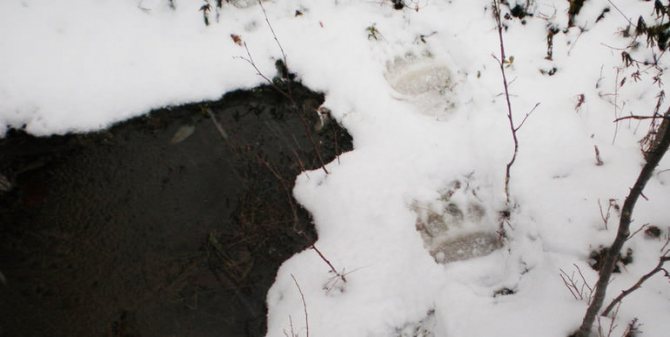
Bear trail
In summer, clear bear tracks can be seen on sand and damp soil, but the trail chain is not as noticeable as in winter.
More photos of bear tracks:
Wolf tracks
The tracks of wolves are very similar to the paw prints of large dogs. However, there are also differences. The front toes of a wolf are more forward and are separated from the hind toes by the width of a match, while in dogs, the toes are gathered together and such a gap is no longer observed. Experienced hunters can distinguish from the scent what kind of gait the animal moved at a walk, trot, gallop or gallop.
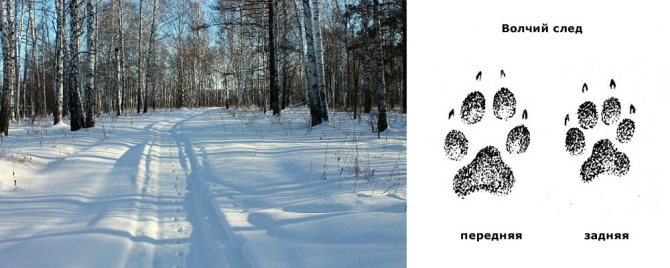
Photo of wolf tracks in the snow added by user Sibiriak in 2014.
Let's look at the difference between the tracks of a wolf and a dog, in the photo
Wild animals do not spread their fingers like their counterparts, so their tracks always look more collected or “slender.” Thus, the paw print of a large dog and a small wolf in the snow will still be different: a small but collected footprint will not allow it to be confused with a large and wide wolf print. The pet initially holds its paw as if in a fist and gently advances. By lowering its paw onto its toes, the dog does not spread them out, since it does not need to increase the area of support.
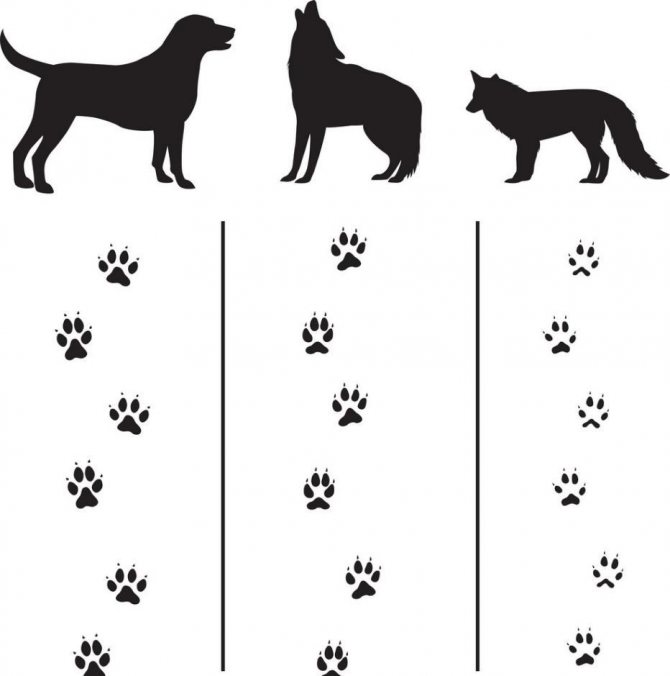
We will further understand the difference between a dog's track and a wolf's. If you number the wolf claws from 1 to 4, you can see that they are located in pairs: the first and fourth are on the same level and you can draw a straight line from their claws. And the second and third are set slightly forward, while their beginning will lie on the line of the claws of the first pair. Between the second, you can also mentally draw a straight line parallel to the first. This will not work for a dog - all its fingers are located in a semicircle and at the same distance from each other.
More photos of wolf tracks:
Wolverine tracks
It is difficult to confuse wolverine tracks with anyone else's. The front and hind feet have five toes. The length of the front paw print is about 10 cm, the width is 7-9 cm. The hind paw is slightly smaller. The snow is often imprinted with a horseshoe-shaped metacarpal callus and a carpal callus located directly behind it. The first shortest toe of the front and hind paws may not be imprinted on the snow.

Photo of wolverine tracks in the snow added by user Tundravik in 2014.
Polar bear
About 600 thousand years ago, the polar bear separated from a common ancestor with the brown species. It occupied its ecological niche, received a number of morphological differences from its ancestor, but remained genetically similar to it.
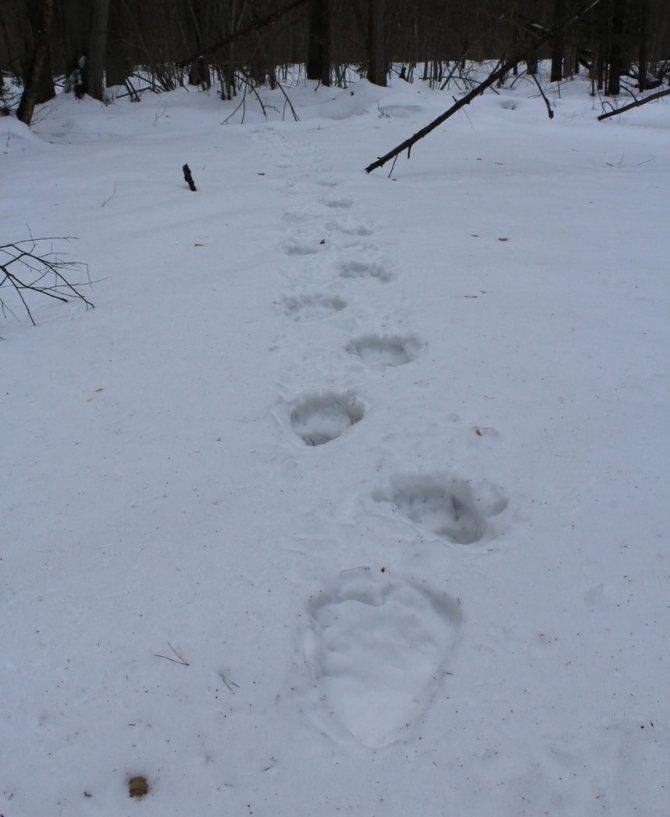
The polar bear is the largest predatory animal living in Russia. A mature male can weigh 650-800 kg. The body length of the animal is 200-250 cm plus a relatively small tail. The predator's paws are powerful and huge. The footprint of a polar bear is different from that of its brown counterpart. The animal's feet are wider and longer, and its toes are connected by thick swimming membranes. The polar bear's claws are thick and curved, they are much shorter than those of the brown bear, but are more adapted to moving on ice.
The undersides of the front and hind paws are overgrown with thick hair; modest areas on the paw pads remain smooth. The forelimbs still have an ungrown transverse callus, which is significantly narrower than that of the brown species.
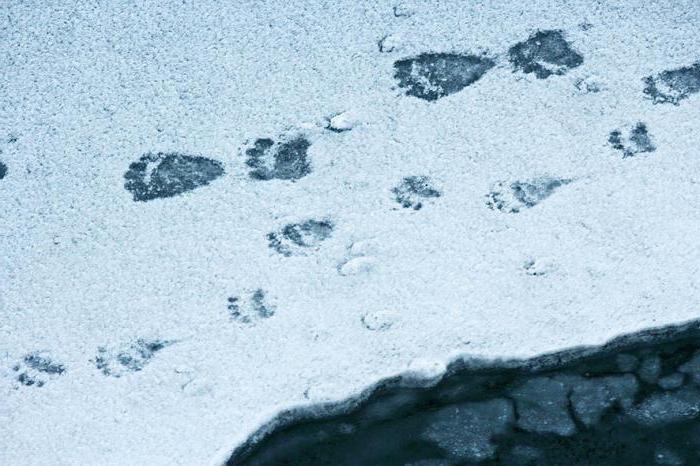
Bear tracks in the snow, left by the front paws, are distinguished by noticeable imprints of thick claws. But the claws do not imprint on the ground.
An inexperienced traveler may confuse the print of a polar bear's hind paws with the prints of human feet in warm fur shoes. The paw prints of brown bears are vaguely similar to the footprints of human bare feet.
Boar tracks
It is not difficult to distinguish the footprint of an adult wild boar from the traces of other ungulates, because in addition to the imprint of the hoof itself, a trace of stepson fingers located on the side remains on the snow or ground. It is interesting that in young piglets in the first months of life these fingers are not supporting, and therefore do not leave a mark.

Photo of wild boar tracks in the snow added by user Hanter57 in 2014.
More photos:
More photos of roe deer tracks:
Lynx trail
The size of the footprint of the front paws of adult individuals is about 8 cm in length and the same in width, the hind paws are slightly smaller. The length of a measured trot stride is about 60 cm for males and 45 cm for females. The young animals have a shorter stride, but they follow their mother in single file, trying to follow the trail.

Photo of lynx tracks in the snow added by user Sasha_27 in 2012.
Animal differences
First of all, it is worth noting the obvious difference: the wolf is a wild animal, and the dog is domesticated by man, which is distinguished by the diversity of species and significant differences in appearance, which sometimes make them completely different from representatives of the same canine family. But even those breeds that really look like their wild relatives have a number of characteristic features, knowing which you can easily distinguish one animal from another.
The differences between a wolf and a dog are manifested in the following parameters:
- Dimensions. As a rule, wolves are larger in size. Their average weight ranges from 34-55 kg, but sometimes males can gain up to 80 kg of mass.
- Head shape and muzzle. The wolf's head is shaped like the head of the German Shepherd breed, but it is more massive and has a more elongated and pointed muzzle.
- Ears. Wolves are simply not able to press them to their heads, so they always keep them raised. The ears are usually small in size relative to other parts of the body and are overgrown with hair on both the outer and inner surfaces.

- Tail. In wild predators, the tail never curls, is held horizontally to the ground or lowered down and always remains practically motionless. Only pets are characterized by wagging their tail to express emotions.
- Jaws. Representatives of wolves have a fairly narrow jaw, which is characterized by greater strength.
- Eating. Wild predators always eat very slowly because they may choke.
On a note! The characteristic groans and whines during a meal are associated precisely with the rapid swallowing of food, as a result of which wolves experience pain.
- Movement style. The wild predator moves at a trot, and its hind legs are placed exactly in the already imprinted tracks of the forelimbs. When moving in groups, they follow each other in the tracks of the first animal in the pack, which makes it easier to move long distances.
- Movement speed. Although predators can stalk prey for days, they cannot sustain high-speed pursuit over long distances (more than 300 m).
- Attitude towards prey. During a hunt or fight, a dog immediately bites the victim to death, while a wolf seems to cut it into pieces, which is due to the anatomical features of the structure of the jaws.
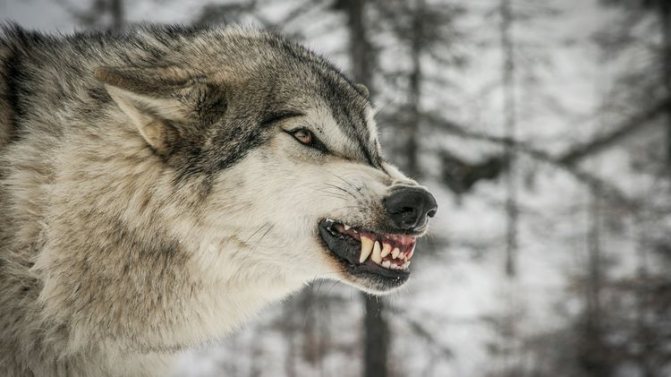
More photos:
Sable trail
Sable tracks in the snow are usually not clear; not every hunter can notice and recognize them. In terms of the size of the print, they are not inferior to fox tracks, and when moving with a three-legged foot ( 3 ), their character resembles that of a hare. Basically, the animal moves with a step characteristic of all mustelids - a two-step step ( 1 ). On dense snow, the imprint can be from 7 to 10 cm in length and up to 6 cm in width. In this case, the length of the jump is on average 45-75 cm. On loose snow, paired prints most often merge into one hole ( 2 ) and the length of the jump is no more than 30 cm. However, when escaping from a chase or while hunting, a sable can jump up to 2 m.

Photo of sable tracks in the snow added by user Valdemar38 in 2017.
Bear tracks in winter
When tracking a bear on a hunt, it is very important to determine how long ago it passed by. To do this, you need to be able to recognize the freshness of a bear's paw print. Bear tracks in the snow can only be seen in late autumn. This may be in winter, but these will already be the prints of a connecting rod bear, which you should beware of. You should be wary and change your route if bear paw prints become noticeable in early spring or winter, at which time the animal is hungry and dangerous. If there was snowfall at night or in the evening, and the prints are not dusty, then they are fresh, the bear passed several hours ago. Trackers are able to determine the freshness of a paw print by touch: during frosty weather, the snow becomes dry and hard. In this case, the edges of the print become harder over time as the temperature decreases, i.e. if the boundaries of the track do not differ in looseness from the surrounding snow, the bear passed recently, and vice versa. In summer, the freshness of the footprint can be determined by the degree of filling of the depression from the sole with water, the windiness and aridity of its borders. You can always determine the degree of weathering or dryness of a print by comparing it with your fresh footprint placed next to it. The fewer differences between the two prints, the fresher the trace. A simple way to determine how old a print has been left is to separate the footprint in the snow with a thin branch. If it is easily divided, it is fresh; if it is difficult, then it was left a long time ago, at least a day ago.
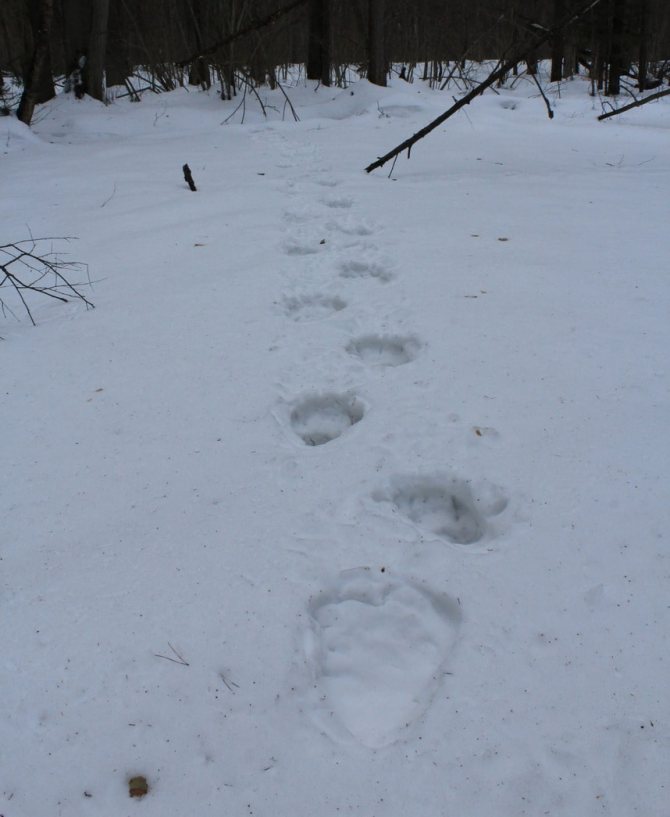
Bear tracks in the snow
To learn how to correctly assess the degree of freshness of prints on various surfaces in winter and summer, you can practice before a planned hike in the forest: leave hand or foot prints in the evening, and in the morning assess their condition and external signs under certain weather conditions or snow conditions.
The imprint on the snow can also be used to determine the direction in which the animal is moving. For large animals like a bear, this is not difficult to do: the leading edge of the track will look steeper than the trailing edge. Thus, the bear moves in the direction in which the deeper edge of its print in the snow points.
The fact that there is a bear den nearby can be recognized by the following characteristic signs: broken spruce branches, torn moss or blueberry twigs (the animal uses them to make bedding inside the den). The hole for entering the den itself is usually noticeable: the snow along its edges has a yellowish tint. The hole is usually facing south.
The footprint of a polar bear is different from that of a brown bear. It is characterized by the presence of finger pad patterns and claw marks. The outline of its paws is more neat, since they are less calloused than those of a brown bear. The hind paws of a polar bear leave imprints on the snow with traces of fur: this resembles the stripes left by a broom on the snow, especially if it is loose.
More photos of sable tracks:
In the comments, you can share links to your photographs of winter tracks posted on the website in the gallery of hunting photos in the “Pathfinder” section.

